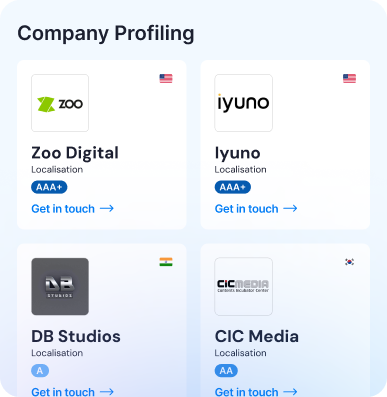Introduction
Ever wondered what makes a hit TV show tick?
Or maybe you’re a creator trying to figure out where your brilliant idea fits in the vast television landscape. Understanding the List of TV Formats is crucial.
It’s not just about categorizing shows; it’s about understanding what audiences crave, what broadcasters are looking for, and how to structure your own creative vision for success. You see, the world of television is built on formats – some timeless, some brand new, but all with a specific DNA.
In this post, I’m going to walk you through the essential TV formats, break down what defines them, and show you how knowing this can give you an edge, whether you’re buying, selling, or creating content. Let’s decode the building blocks of television entertainment!
Curious how Vitrina can help you? Try it out today!
Trusted by global entertainment leaders to grow business, acquire high-demand content, promote projects and services, and track every Film + TV production worldwide
Table of content
- Introduction
- Key-Takeaways
- What Exactly IS a TV Format Anyway?
- Scripted Formats: The World of Storytelling
- Unscripted Formats: Reality and Entertainment
- Game Shows: Play Along at Home
- Talk & Variety Shows: Personality-Driven Content
- Hybrid Formats: Blurring the Lines
- Why Understanding TV Formats is Your Secret Weapon
- How Vitrina Helps You Navigate the World of TV Formats
- Conclusion
- FAQs
Key Takeaways
| Key Area | Main Insight | Actionable Tip |
|---|---|---|
| Format Definition | A TV format is the overall concept, premise, and branding of a copyrighted television program that can be adapted and licensed for different markets. | Analyze successful formats to understand their core repeatable elements. |
| Scripted vs. Unscripted | The primary division in TV formats, dictating production style, budget, and audience appeal. | Decide early if your idea leans towards narrative control (scripted) or spontaneous reality (unscripted). |
| Key Format Types | Sitcoms, Dramas, Reality TV, Game Shows, and Talk Shows represent major categories with distinct structures. | Study examples from each category to identify common tropes and opportunities for innovation. |
| Format Licensing | Successful formats are often licensed internationally, generating significant revenue. | If creating, think about elements that could have global appeal and adaptability. |
| Audience Engagement | Each format type engages audiences differently, tapping into various emotional and entertainment needs. | Align your chosen format with the target audience and the kind of engagement you want to foster. |
Overwhelmed by the Variety of TV Formats?

What Exactly IS a TV Format Anyway?
Before we dive into the nitty-gritty list, let’s get on the same page. A TV format isn’t just the genre, like “comedy” or “drama.”
It’s much more specific. Think of it as the blueprint or the recipe for a show. It includes the underlying concept, the rules, the structure, the characters (if scripted), the visual style, and even the branding elements that make a show unique and, crucially, replicable.
You’ve seen this in action, right? Shows like “The Office” started in the UK, then got adapted in the US, Germany, and many other countries. That’s format licensing in a nutshell. The core idea was strong enough to travel.
Understanding this is key because it unlocks opportunities for international co-production and sales – something we at Vitrina are passionate about helping you discover.
1. Scripted Formats: The World of Storytelling
Scripted formats are all about compelling narratives, well-developed characters, and dialogue written by a team of writers. These are the shows that often have us binge-watching entire seasons in a weekend!
Drama Series
Dramas are the heavy hitters, often exploring complex themes, character arcs, and serialized storylines. Think emotional depth and high stakes. You’ve got your epic fantasies, gritty crime sagas, and heartfelt family stories here.
- Typically hour-long episodes.
- Focus on character development over multiple seasons.
- Can be serialized (story continues week to week) or episodic (each episode a standalone story, with overarching character arcs).
- Examples: Breaking Bad, Stranger Things, The Crown.
The challenge with dramas? They often require significant investment in writing, talent, and production value. But the payoff can be huge, creating dedicated fanbases and critical acclaim.
Situation Comedies (Sitcoms)
Sitcoms, or situation comedies, aim to make us laugh through relatable characters in everyday (or not-so-everyday) funny situations. They’re a staple of TV schedules worldwide.
- Typically half-hour episodes.
- Often feature a recurring cast in a fixed setting (e.g., home, workplace).
- Can be multi-camera (filmed in front of a live studio audience or with a laugh track) or single-camera (more cinematic, no laugh track).
- Examples: Friends, The Office (US), Modern Family.
What’s the secret sauce? Strong comedic voices, memorable characters, and universal themes of family, friendship, and work. A great sitcom format can be incredibly lucrative and long-running.
Procedurals
These are a sub-genre of drama but so prevalent they deserve their own mention. Procedurals follow a case-of-the-week structure, often involving crime-solving, legal battles, or medical mysteries. Each episode typically resolves a specific case while longer character arcs may unfold across the season.
- Highly structured and repeatable episode format.
- Appeals to audiences who enjoy puzzle-solving and satisfying resolutions.
- Easy for new viewers to jump in at any point.
- Examples: Law & Order, CSI, Grey’s Anatomy (early seasons).
Procedurals are format goldmines because their structure is so clear and adaptable. If you’re looking for global content acquisition or co-production insights, checking out the Vitrina Project Tracker can reveal trends in procedural adaptations.
2. Unscripted Formats: Reality and Entertainment
Unscripted television, often called “reality TV,” covers a massive range of programming. The common thread?
These shows feature real people (not actors playing characters) in various situations, ideally behaving spontaneously. Of course, there’s always a degree of production guidance and editing, but the “unscripted” label sticks.
Reality Competition Shows
These are huge! From singing contests to cooking battles to surviving on a deserted island, competition formats pit contestants against each other for a prize. The drama comes from the challenges, eliminations, and interpersonal dynamics.
- Clear rules and elimination processes.
- Often feature celebrity judges or hosts.
- High audience engagement through voting or rooting for favorites.
- Examples: Survivor, The Voice, MasterChef.
Data suggests these formats travel incredibly well. The core competitive element is universally understood, making them ripe for local adaptation. Finding the right production partner for such an adaptation is critical, which is where a platform like Vitrina can provide invaluable connections.
Docu-series and Observational Documentaries
These formats follow the real lives of individuals, groups, or the workings of an organization over a period. They offer a window into different worlds, often with a more serious or informative tone than other reality TV.
- Can be serialized, following an ongoing story.
- Focus on authentic storytelling and character journeys.
- Range from “fly-on-the-wall” style to more produced narratives.
- Examples: Making a Murderer, Cheer, Deadliest Catch.
Makeover & Lifestyle Shows
These shows focus on transformation – whether it’s a home, a person’s style, a business, or a garden. They are often aspirational and offer practical tips.
- Usually feature experts guiding the transformation.
- Strong “before and after” appeal.
- Can cover a wide range of topics: home improvement, fashion, cooking, travel.
- Examples: Queer Eye, Property Brothers, Chef’s Table (which blends documentary with lifestyle).
Ready to Find Your Next Winning TV Format?

3. Game Shows: Play Along at Home
Game shows are built around contests of skill, luck, or knowledge, where contestants compete for prizes. They are designed for audience participation, encouraging viewers to shout answers at the screen!
- Simple, clear rules are essential.
- Often feature charismatic hosts.
- Can be studio-based or involve physical challenges.
- Enduring appeal across generations.
- Examples: Jeopardy!, Wheel of Fortune, The Price is Right.
I’ve seen many game show formats achieve incredible longevity. Why? Because the core mechanic is often timeless. If you have a clever game show idea, the key is a strong, easily understandable concept that can be produced efficiently.
| Game Show Element | Importance |
|---|---|
| Clear Rules | Contestants and viewers must understand how to play instantly. |
| Engaging Host | Drives the energy and connects with contestants and audience. |
| Play-along Factor | Crucial for home viewer engagement. |
| Prizes | Adds stakes and excitement, but the game itself must be compelling. |
4. Talk & Variety Shows: Personality-Driven Content
These formats are centered around a host or group of hosts who discuss current events, interview guests, and may include comedic sketches or musical performances. They are highly dependent on the talent and charisma of the host(s).
- Can be daily or weekly.
- Topical and timely content is often key.
- Segments can include monologues, celebrity interviews, games, and performances.
- Examples: The Tonight Show Starring Jimmy Fallon, The Ellen DeGeneres Show, The Graham Norton Show.
The success of a talk show format often hinges on the unique perspective and appeal of its host. While the format itself (desk, couch, guests) is common, the execution and personality make it distinct.
5. Hybrid Formats: Blurring the Lines
As television evolves, we’re seeing more and more hybrid formats that blend elements from different categories. This is where a lot of innovation happens!
- Dramedy: Mixes drama and comedy (e.g., Fleabag, Barry).
- Scripted Reality / Structured Reality: Features real people in situations that are more heavily produced or “soft-scripted” to guide storylines (e.g., The Hills, Made in Chelsea).
- Competition with strong docu-elements: A baking show that also delves deep into the personal lives of contestants.
- Hidden Camera with Game Elements: Shows that involve pranking unsuspecting people but with a competitive or prize element.
The beauty of hybrid formats is their ability to surprise audiences and carve out new niches. If you’re developing content, don’t be afraid to mix and match elements if it serves your core idea. The global TV market is always hungry for fresh takes.
Why Understanding TV Formats is Your Secret Weapon
So, why go through this whole List of TV Formats? Because knowledge is power, my friends.
For Creators: Understanding formats helps you structure your ideas, identify your target audience, and pitch your show effectively. You’re not just selling a story; you’re selling a replicable, potentially global, concept.
For Producers & Broadcasters: Knowing format trends, what works where, and what’s adaptable is crucial for making smart commissioning and acquisition decisions. You don’t want to reinvent the wheel if a proven format can be localized successfully.
For Distributors & Buyers: A clear format makes a show easier to sell and acquire internationally. The “bible” of the format – its core elements – can be translated across cultures and languages.
Essentially, understanding TV formats is about understanding the business of television. It’s about recognizing patterns, predicting success, and ultimately, connecting with audiences on a massive scale.
How Vitrina Helps You Navigate the World of TV Formats
Navigating the complex world of TV formats, from identifying hit shows in one market to understanding their adaptation potential in another, can be a daunting task. That’s where Vitrina comes in.
Our platform provides AI-powered intelligence and a global database on content, deals, and companies in the media and entertainment industry.
Whether you’re looking to acquire a proven format, find co-production partners for a new scripted series, identify successful unscripted shows ripe for adaptation, or track who’s buying what, Vitrina offers the data and connections to make informed decisions and discover new opportunities. We help you cut through the noise and connect with the right content and partners, faster.
Conclusion
And there you have it – a rundown of the major TV formats that shape what we watch. From the intricate narratives of scripted dramas to the spontaneous excitement of unscripted shows and the pure fun of game shows, each format has its own unique power to entertain, engage, and even travel the world.
The key takeaway? Understanding this List of TV Formats isn’t just academic; it’s a practical tool.
It helps you see the structure behind the magic, making you a smarter creator, producer, or buyer in this ever-evolving industry. The television landscape is dynamic, with new hybrid formats emerging all the time. By grasping the fundamentals, you’re better equipped to spot opportunities and make your mark.
What’s the first strategy you’re going to try? Or which TV format fascinates you the most right now? Let me know in the comments.
Ready to Supercharge Your Content Strategy?
Don’t just guess what’s next in television. Get the data, insights, and connections you need to succeed. With Vitrina, you can explore a world of content opportunities, from tracking successful TV formats to finding your next global partner. Stop searching, start connecting.
Sign up for Vitrina today and transform the way you discover and deal in the entertainment industry!
Frequently Asked Questions
A TV show is a specific production (e.g., “The Office US”). A TV format is the underlying concept, structure, and branding that can be licensed and adapted to create new, localized versions of that show (e.g., “The Office” format, which led to versions in many countries).
Both are incredibly popular and serve different audience needs. Unscripted formats like reality competitions and game shows often have broad, immediate appeal and can be very cost-effective to produce and adapt. Scripted formats, especially high-quality dramas and sitcoms, can build deep audience loyalty and critical acclaim, often leading to valuable IP. Trends vary by market and over time.
Format licensing typically involves an agreement between the format owner (often a production company or distributor) and a producer or broadcaster in another territory. The licensee pays a fee and often receives a “bible” detailing how to produce the show. Finding who owns the rights to a specific format can be part of the research that platforms like Vitrinacan assist with.
Absolutely! Many successful formats started as original ideas. The key is to develop a strong, distinct concept with clear, repeatable elements. Think about what makes your idea unique and how it could potentially be adapted for different audiences or markets. Protecting your intellectual property is also crucial.































